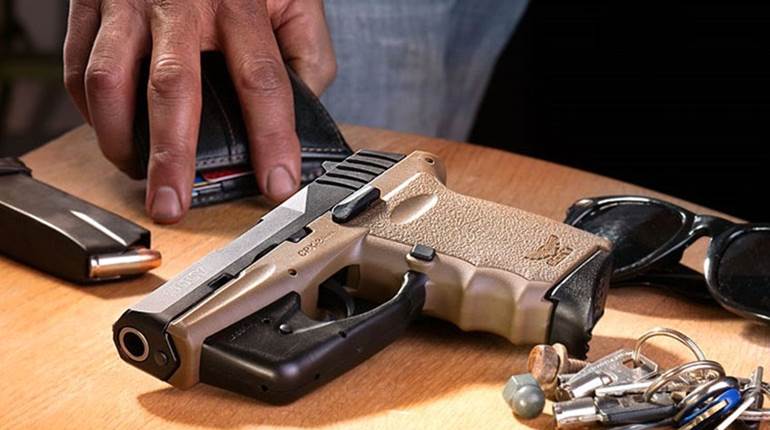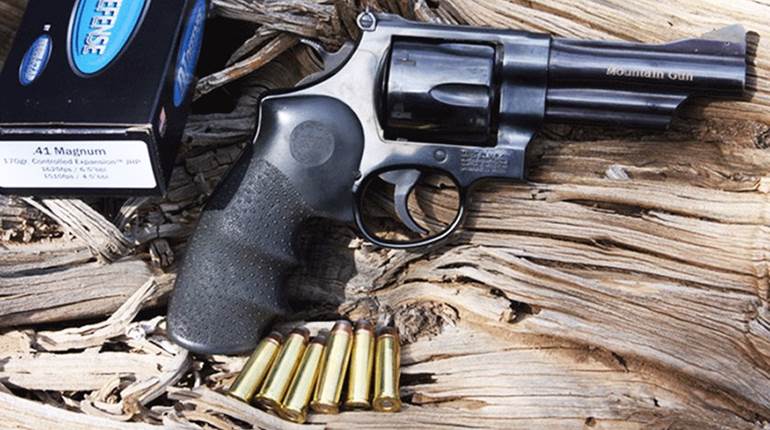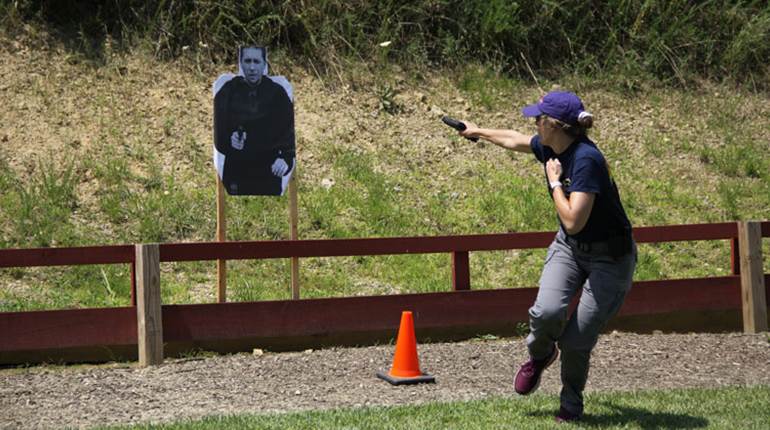
There is little doubt that, nearly 97 years after its adoption by the U.S. military, the John Browning-designed M1911 is America’s most popular center-fire, semi-automatic handgun. At present, there are at least 25 firearm makers offering M1911-based pistols—and that’s just the current cataloged factory offerings. Add in custom pistolsmiths and smaller makers, and the number is considerably higher. You can get just about any feature you could possibly desire on an M1911, frequently as a package on a factory gun. With so many offerings, what sets one maker apart from another?
That’s a larger question than I have space to answer here, but for Para USA making the M1911 a little different is what it has always done. While there’s no need to rehash Para’s role in the development of the modern M1911, Para is credited in particular for popularizing wide-body M1911 .45s, for its unique LDA (Light Double-Action) trigger and for its proprietary enlarged internal Power Extractor. Ted Szabo was responsible for many such engineering innovations at Para USA. Sadly, the brilliant and extremely affable Szabo passed away last year, but two new M1911-platforms just introduced demonstrate that his spirit of innovation lives on. They showcase the features that set Paras apart on both sides of the M1911 size spectrum. They are the Super Hawg and the PDA; big and small.
Small: The Personal Defense Assistant (PDA)
It’s actually not much larger than the first electronic PDA I carried briefly years ago. No, it doesn’t sync up to my computer, but then again my PC doesn’t have provision for an eight-round capacity 9 mm magazine, either. The PDA is built on a new, smaller dedicated frame with a magazine Para dimensioned specifically for the 9 mm cartridge. This is no .45 with a spacer in the magazine well. The frame’s circumference has been reduced to 5 1/16 inches just below the grip safety as the maximum cartridge overall length for the 9 mm is 1.169 inches (as opposed to 1.275 inches for the .45 ACP). The PDA measures 1.94 inches across its grip frame, while the frame with stocks is 1.10 inches wide (1.22 inches if you include the extended safety lever on the left). The gun is 5.10 inches high and, thanks to its aluminum frame, weighs a mere 24 ounces unloaded. While all of a pistol’s dimensions contribute to its overall concealability, it is my opinion that the size of the grip frame is the most important in making a gun disappear on your person. The thin grip panels, flat mainspring housing and short fore-to-aft frame length all make the PDA one of the most concealable handguns introduced since the ultimate in hideout autoloaders, the Colt Model 1903. But this gun has modern safeties and is a 9 mm—a far more effective self-defense cartridge than the .32 and .380 ACPs of the 1903.
The PDA is neither fish nor fowl; its features put it in a category in and of itself. It works like the modern polymer-frame semi-automatic carry pistols but with a bobbed hammer—instead of a partially pre-cocked internal striker—on an abbreviated aluminum M1911 frame with a traditional grip safety and an extended manual safety on the left side. The hammer (which cannot be thumb cocked) is pushed rearward by the movement of the slide (manually or under recoil), and the mainspring is cocked. Yet the hammer returns to the forward at-rest position as the slide travels back forward and into battery. The trigger is powered by a mousetrap-style spring suspended by a trigger pin at the blade’s top. There is a trigger bar on the top right of the frame between the front and back guide rail surfaces (instead of one long rail, there are abbreviated sections on the frame’s rear and above the slide stop to guide the slide’s travel). Drawing the trigger back gives you the weight of a conventional single-action trigger (about 5 1/2 pounds) but with the pull length of a double-action-only. The LDA-equipped guns do not have a second-strike capability. Personally, I’m willing to give up the second strike (which would require a heavier pull weight due to overcoming the resistance of compressing the mainspring) for a better trigger.
The stumpy stainless barrel is rifled with a six-groove 1:16-inch twist rate, and has an integral feed ramp. It measures 3 inches in length and locks up via two lugs on top of the barrel. The PDA uses the familiar Browning M1911 pivoting link system where the barrel drops down out of engagement as the slide travels rearward. The 0.70-inch diameter barrel is bushingless and was well fit within the slide. Its dual-nested captive recoil springs surround a two-piece telescoping guide rod with a stop plate at its rear. There is rear-facing bushing for the guide rod. A notch cut in the rear of the barrel hood serves as a loaded-chamber indicator (all new Paras have them), allowing users to view the rim of a cartridge through the slot. As the trigger is pulled, a passive firing pin safety plunger in the slide’s underside is depressed by a tab in the fire-control block. The tab is only lifted when the trigger is fully depressed.
There is no need for a beavertail on the grip safety, as the bobbed hammer cannot bite the web of the shooter’s hand. The mainspring housing is checkered, while the frame’s front is left smooth. The Power Extractor is on the slide’s inside right, while the fixed-blade ejector is on the frame’s left, where one would expect. Dovetailed into the slide at front and rear, the sights are drift adjustable for windage. The three-dot sights are extremely usable for shooting, but are not so high as to be troublesome for discreet carry. With a fenced flat surface on the rear, they are an excellent compromise between being snag-free and visible. The gun I received was pre-production and had non-illuminated sights. Night sights with Tritium tube inserts will be standard on the production guns. Also, the final-specification slim PDA cocobolo stocks arrived during testing but after photography had started. The gray laminate units will not be offered.
I carried the PDA daily for about a week in inside-the pants and belt-slide holsters from Galco and Kramer and fired a number of close-range shooting drills with the little gun in addition to the accuracy testing. It carried extremely well, rode comfortably in both holsters and, thanks to the thin and shallow grip frame, did not readily print. Admittedly, recoil with 9 mm defensive loads was snappy, but the gun was controllable enough for accurate double taps at 7 yards, and not nearly as punishing as some other guns in this size class. Fired from a Caldwell HAMMR machine rest, it proved quite accurate for a gun with such a short barrel.
A smooth double-action trigger pull, the familiar M1911 grip angle, a manual safety, light weight and a very concealable overall package size make the PDA one of the most worthy carry options fielded today. I think the name is clever, and the gun delivers in its intended role. For those that regard 9 mm as marginal for personal protection, .45 GAP and .40 S&W versions are planned, as is a larger-framed .45 ACP PDA.
Big: Super Hawg
In popular culture, the .45 longslide will always be associated with the movie “Terminator.” But the nefarious on-screen context in popular culture can’t take away the virtues of this M1911 modification. Jim Clark, the late pistolsmithing pioneer, gets the credit for the development of 6-inch longslides he made by cutting slides then welding an extra inch or so into them during the beginnings of practical pistol shooting competition in the 1960s. Back then—as now—the extra weight up front and the extended sight radius are attractive features on a competition pistol—particularly on bowling pin guns that were all the rage for many years. Although compensators and weights have taken the place of longer slides on most race guns, there’s nothing wrong with an extra inch of barrel length, and they are generally softer shooting than any other stock uncompensated .45 ACP M1911 variants. Spread the recoil across a wide body grip frame, and you really have something.
When it comes to the 6-inch-barreled stainless steel gun covered here, I find the name Super Hawg not only typographically incorrect but also misleading. While big and heavy, this gun is no pig in the hand. The Super Hawg is one of the biggest, longest and heaviest M1911s made today, and that’s a good thing. Spend some time on the range with one, and you’ll agree.
The Super Hawg weighs in at a beefy 44 ounces unloaded and is built on Para’s 14-round-capacity, widebody stainless steel frame, which measures 5 3/4 inches in circumference around the grip frame. The gun is 9 3/4 inches long, 1.43 inches across its extended ambidextrous safety levers and 5 1/4 inches high.
Instead of cut and joined pieces, the slide is one piece of solid machined stainless with high-polish side flats and brushed matte surfaces everywhere else. There are semi-circular grasping grooves at both the front and the rear. While aesthetically pleasing, I prefer such grooves cut a bit deeper with more pronounced edges, but that’s me. Measuring 8.47 inches in length, the slide’s increased length and weight over a 5-inch Government Model reduces muzzle flip considerably, although it does add slightly to the time requisite for the pistol to cycle. It might mess up the timing of the likes of Todd Jarrett, but for me, I was actually faster back on target with the Super Hawg than with a standard gun.
The six-groove match-grade stainless barrel measures 6.06 inches in length, and it has an integral feed ramp. Again, there are two lugs on the barrel top, and it is built on the Browning pivoting-link system. The barrel is retained by a standard bushing. There are two recoil springs of differing lengths, one is 6 1/2 inches long and another measures 1 1/4 inches uncompressed. Slide fit was extremely tight with no wobble, and the barrel hood was very well fitted. The internal Power Extractor and a conventional frame-mounted blade ejector are also standard.
The square-notch, target-style rear sight, made by Para, is dovetailed into the slide and is both windage and elevation adjustable via screws on the right side and top. Its rear face is grooved horizontally to reduce glare. The front, too, is dovetailed in and is drift adjustable for windage. A red fiber-optic rod in the front is a departure, and I found it faster to acquire—especially in low light—than straight Bo Mars, while still being able to precisely aim at both reactive and Bullseye targets.
Ergonomic touches included a skeletonized match trigger adjustable for overtravel via a trigger stop screw, a well-fitted stainless beavertail grip safety and an ambidextrous extended thumb safety. The black stocks are of checkered hard polymer and are retained by stainless hex screws. The flat mainspring housing is checkered at 25 lines per inch, while the frontstrap has fine, negative 30 line-per-inch checkering cut into the frame. The latter is non-abrading, yet provides a firm grip, and Para is to be commended for it. Single-stack longslides will also be available from Para.
The frame circumference of the doublewide .45 ACP Super Hawg is 5 3/4 inches as compared to 5 1/16 inches for the 9 mm Luger PDA. As can be seen in the accompanying table, accuracy was quite good, with the .45 ACP Super Hawg at 25 yards from a Caldwell HAMMR machine rest. There were five failures to feed the top round from the magazine with Federal Gold Medal Match FMJ SWC loads early in the testing. After 425 additional rounds had been fired, the broken-in gun chambered them without difficulty. With a 230-grain JHP load, we found the extra inch of barrel delivered about 10 foot pounds more muzzle energy than a conventional 5 inch. It might not seem like much, but it certainly doesn’t hurt anything, either. The Super Hawg was so much fun on the range that it made me rethink why I haven’t paid more attention to longslides. I fired several hundred more rounds than I typically do on such an evaluation with the gun simply because the gun was so much fun to shoot. Thanks to its accuracy and excellent handling, the Super Hawg is waiting for my next hog hunt and has me checking the Internet for local bowling pin matches.
I was impressed by these two guns, and the thought and appreciation for Browning’s grand design behind them. The M1911 will no doubt continue as our most popular center-fire semi-automatic pistol platform, and it will continue to expand in versatility and configuration … especially if the guys at Para USA have anything to say about it.






































